
About UsThe Numismatic Bibliomania Society is a non-profit organization promoting numismatic literature. For more information please see our web site at coinbooks.org SubscriptionsThose wishing to become new E-Sylum subscribers (or wishing to Unsubscribe) can go to the following web page link MembershipThere is a membership application available on the web site Membership Application To join, print the application and return it with your check to the address printed on the application. Membership is only $15 to addresses in the U.S., $20 for First Class mail, and $25 elsewhere. For those without web access, write to: David M. Sundman, Secretary/TreasurerNumismatic Bibliomania
Society AsylumFor Asylum mailing address changes and other membership questions, contact David at this email address: dsundman@LittletonCoin.com SubmissionsTo submit items for publication in The E-Sylum, just Reply to this message, or write to the Editor at this address: whomren@coinlibrary.com
BUY THE BOOK BEFORE THE COINYou won't regret it! |
- WAYNE'S WORDS: THE E-SYLUM NOVEMBER 13, 2011
- QUARTERMAN COIN BOOK INVENTORY DEEPLY DISCOUNTED
- KRAUSE PUBLICATIONS WAREHOUSE SALE
- BOOK REVIEW: CHERRYPICKERS' GUIDE TO RARE DIE VARIETIES OF UNITED STATES COINS
- BOOK REVIEW: UNUSUAL WORLD COINS
- THE NUMISMATOURIST REPORTS FROM ISRAEL
- SKEWING INSTRUCTIONS, STEP-BY-STEP
- MORE ON THOMAS ELDER PERIODICALS
- ALASKAN NATIONAL BANK NOTE THIEF SENTENCED
- NOTES FROM E-SYLUM READERS: NOVEMBER 13, 2011
- QUICK QUIZ: RAY WILLIAMS' MYSTERY MARKS
- COCKNEY ATMS AND BRITISH SLANG TERMS FOR MONEY
- MORE ON PEWTER TRIBUTE MEDALS
- WAYNE'S NUMISMATIC DIARY: NOVEMBER 8, 2011
- BRITISH STONEMASONS UNCOVER HIDDEN COINS HIGH ATOP CHURCH
- LANGUAGE ON COINS AND CURRENCY OF LANKA
- DAILY MAIL ARTICLE ON MONEYFACING
- FEATURED WEB PAGE: ALUMINUM COIN COLLECTOR'S SOCIETY
WAYNE'S WORDS: THE E-SYLUM NOVEMBER 13, 2011

Among our new subscribers this week are Professor Thom Curtis, courtesy of John and Nancy Wilson, and Mark Benvenuto. Welcome aboard! We have 1,471 email subscribers, plus 167 followers on Facebook.
This week we open with not one, but TWO numismatic literature warehouse sales. Get your orders in quick! Next up are two new books, reviewed by Michael Luck and Dick Johnson, and a report from Howard Berlin on numismatic sights seen on his recent trip to Israel.
Other topics this week include Thomas Elder periodicals, pewter "tribute" medals, and language on coins and currency of Sri Lanka.
To learn more about the Shrine of the Book, Stuart Mosher's heart attack, Cockney Rhyming slang terms for money, and the 1804 Dollar discovered in a British church, read on. Have a great week, everyone!
Wayne Homren
Numismatic Bibliomania Society
QUARTERMAN COIN BOOK INVENTORY DEEPLY DISCOUNTED
There are only a small number of copies available of some of these titles, so act fast to fill holes in your library or add to your inventory. Complete price lists of coin and stamp books are available on request. -Editor
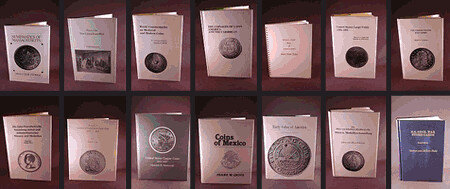
My dad, who received the Kolbe award posthumously this year has quite a bit of coin books left in inventory from Quarterman Publications. I would like to offer at least a 75% discount off of retail, plus shipping costs of any of the book titles (depending on the quantity) to NBS members or NBS dealers.
The titles available are:
| Author | Title | Retail Price | Now Only |
| Adams | Plates of Lyman H. Low's Hard Times Tokens | $35.00 | $8.75 |
| Brunk | World Countermarks on Medieval and Modern Coins | $35.00 | $8.75 |
| Crosby | Early Coins of America | $50.00 | $12.50 |
| Erbstein | Die Ritter von Schulthess-Rechberg'sche Münz-u: Medaillen-Sammlung | $50.00 | $12.25 |
| Fuld | Civil War Store Cards | $100.00 | $25.00 |
| Furber | The Coinages of Latin America and the Caribbean | $35.00 | $8.75 |
| Grove | Coins of Mexico | $50.00 | $12.25 |
| Lapp | United States Large Cents 1793-1857 | $40.00 | $10.00 |
| Loring | Varieties of United States Large Cents 1795-1803 | $40.00 | $10.00 |
| Newcomb | United States Copper Cents | $50.00 | $12.25 |
| Stewart | History of the First United States Mint | $40.00 | $10.00 |
| Storer | Numismatics of Massachusetts | $40.00 | $10.00 |
| Valentine | United States Half Dimes | $40.00 | $10.00 |
| Weyl | Die Jules Fonrobert'sche Sammlung mittel- und südamerikanischer Münzen und Medaillen | $25.00 | $6.25 |
Several books on stamps are also available. Please email me at davehoch@technologyarts.com or call (Cell: 617-833-3866) if you are interested.
KRAUSE PUBLICATIONS WAREHOUSE SALE
It's the sale of the century! 11-11-11 only happens once every hundred years! So to celebrate, we are having a once-in-a-lifetime warehouse sale like none other! From 11/11/11 to 11/13/11, we've selected hundreds of great products and are offering them to you virtually at cost! Throughout the stores listed below, you can choose from more than 500 titles all priced at just $3.99 and $4.99. Quantities are limited, so don't delay – you don't want to miss this one-time opportunity to save! No promo codes are needed at checkout, just shop and save!

To see the numismatic titles, visit:
Numismatics Warehouse Sale
(www.shopnumismaster.com/category/numismatics-
warehouse-sale/?r=111111SALE)
BOOK REVIEW: CHERRYPICKERS' GUIDE TO RARE DIE VARIETIES OF UNITED STATES COINS
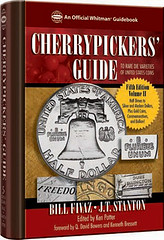 Where should I begin with the most eagerly awaited numismatic book—the Cherrypickers' Guide to Rare Die Varieties of United States Coins, Fifth Edition, Volume II! It covers half dimes to silver and modern dollars, including gold coins, early silver commemoratives, and modern collectible bullion. In my opinion this will become the most sought after, in demand numismatic book of the year, sure to be a bestseller. I have intently studied this book and I'm greatly impressed, to say the least, with not only its quality and the amount of information contained therein, but also with the presentation and collation of the book, making it easy to use.
Where should I begin with the most eagerly awaited numismatic book—the Cherrypickers' Guide to Rare Die Varieties of United States Coins, Fifth Edition, Volume II! It covers half dimes to silver and modern dollars, including gold coins, early silver commemoratives, and modern collectible bullion. In my opinion this will become the most sought after, in demand numismatic book of the year, sure to be a bestseller. I have intently studied this book and I'm greatly impressed, to say the least, with not only its quality and the amount of information contained therein, but also with the presentation and collation of the book, making it easy to use.
This is a guide that will be carried to every coin-selling venue, dealer shops, and shows many times over by collectors and dealers alike. The book will stand up to so much use, because of the quality of the pages and the covering, as it is spiral-bound and wisely encased in a hardcover binding, which protects the spiral. It will handle many years of hard use, all while the pages are easily laid flat without bending them or damaging the spiral of the opened book. Ingenious!
Now, the main book itself: Yes, it took some more time than expected—but in my opinion it was well worth the wait! Whitman Publishing did an expert job using quality paper and excellent large clear photos of each variety listed in this book, with prices that have been carefully updated and are current. Every variety is identified with blown-up photos, and easy to determine attribution information. If it is a new listing it is stated in the description, along with the Fivaz-Stanton numbers (some cross-referenced to older FS numbers where applicable), whether the coin can be found searching in pocket change, if it is listed as a Red Book variety, and more.
A "Young Numismatist" symbol targets varieties that a young or new collector might want to focus on. Each variety has a "pickup point" guide to quickly and correctly help in confirming the attribution; the rarity of the variety based on Dave Bowers' Universal Rarity Scale; interest and salability factors are also listed, using a system which is helpful to many; the list goes on and on. It's a huge wealth of information useful to the new/beginning and/or younger collector, to even the most advanced numismatist.
Overwhelmed yet? Don't be, as the "How to Use This Book" section will make any reader comfortable, with easy to follow and understand instructions.
And last but not least there are appendices with more added information like strike doubling (which causes many collectors to think they have a doubled variety when they do not; this information should clear up any questions or concerns of identification); other forms of "doubling" (e.g., Longacre doubling and die deterioration, which again confuses collectors); an extremely well done explanation of the minting process; "What is the Best Magnifier to Use?"; using tact and respect when cherrypicking; recommended reading; and the important Fivaz-Stanton numbers cross-reference chart.
Bill Fivaz, J.T. Stanton, and the series' new editor, Ken Potter, are known and highly respected experienced variety numismatists, and they outdid themselves with this new updated guide.
Let me end with this note: BUY THIS BOOK!
Thank you for reading my humble critique and good luck in your cherrypicking.
The Cherrypickers' Guide to Rare Die Varieties of United States Coins, fifth edition, volume II
By Bill Fivaz and J.T. Stanton; edited by Ken Potter; forewords by Q. David Bowers and Kenneth Bressett
ISBN 079483239-3
Spiralbound hardcover
512 pages
Retail $39.95
For more information, or to order, see: www.whitmanbooks.com/Default.aspx?Page=81&ProductID=0794832393
BOOK REVIEW: UNUSUAL WORLD COINS
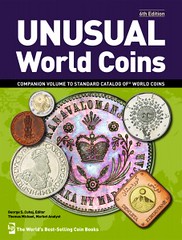 The sixth edition of KP Publications Unusual World Coins arrived two weeks ago. (This review was delayed because of the October storm in the North East where the Johnson house was without power for 2 1/2 days.)
The sixth edition of KP Publications Unusual World Coins arrived two weeks ago. (This review was delayed because of the October storm in the North East where the Johnson house was without power for 2 1/2 days.)
I wrote a 5-page report on this book for the management at Medallic Art Company and sister company NorthWest Territorial Mint. (Medal manufacturer MACO was not, technically a mint until 1966 when it purchased its first coining press, NWT Mint has been a full fledged mint all the time.) The KP book is virtually a catalog of the productions of Private Mints of the World.
As such it is a massive telephone-book size compendium that lists, itemizes, illustrates, briefly describes – and prices! – what private mints have struck over the 222 years since Mathew Boulton established the first private mint, the Soho Mint in Birmingham England, in 1789.
Thus this book is a tribute to Mathew Boulton and what he created – a nongovernment mint with coining capability – the true definition of a private mint. He not only established a mint he improved coining tools and equipment, plus every step of coin and medal manufacture. He build screw presses into coining presses, powered by steam utilizing the steam power engines, which he also manufactured, invented by his partner James Watt. It earned for Boulton a leading position in the Industrial Revolution and the gratitude of every mint official, numismatist, and coin collector for these improvements.
The world of coins, struck by both national and private mints, is chronicled by KP Publications of Iola, Wisconsin. Founded by Chester Krause in 1952, it is now under the banner of F+W Media Inc. The firm publishes the worldly acclaimed Standard Catalogs of World Coins and similar publications on paper money.
It now requires five of those telephone-book size volumes – six if you count a separate catalog of gold coins alone – to list all the coins struck by all the national mints for all the countries in the world. The five World Coins books, grouped by century starting in 1601, list the coins by country within each volume – then by type, then by denomination, then by date – and are constantly revised and updated.
The 17th, 18th, and 19th century World Coins are now in their fifth or sixth edition, and are on a three year rotation. The 20th century edition is now in its 39th since it is published each year. The 21st century volume is also published each year.
All of these printed catalogs are generated from one massive databank, called NumisMaster. By the magic of the computer it can break out all coins listed for the desired century and viola! there's the text and photographs for the next edition with the latest entries entered just days before.
Coins struck by national mints are obviously intended for circulation in the country where located, or by custom minting for nations without their own mints. A few private mints have also struck circulating coins for those counties without mints (as Franklin Mint did here in America for dozens of countries when it was active, 1969 into the 1980s).
But private mints also strike coins for private entities. It is these "coins" that were included in the Krause NumisMaster databank but they didn't get published in any of the legal tender Standard Catalogs. So in 1987 they were gathered up and published under the title Unusual World Coins: A Standard Catalog of World Coins Companion Listing of Novel Non-Circulating Coins.
That Novel Non-Circulating Coins part of the title was important because there was a class of coins, "Non-Circulating Legal Tender" that did get listed in the standard catalogs. These were mostly bullion coins that were given a denomination to make them more attractive to precious metal buyers.
Bullion coins were a 20th century invention, first struck by Mexico (since 1943) and South Africa (Krugerrands since 1967) Their national mints provided a minted product that individuals could own in coined form that had the backing of a nation for weight and purity. These coins were ideal for small investors, or anyone, because they aided every transaction in that the precious metal did not need to be weighed and assessed for purity.
So bullion coins, plus all the other diestruck items struck by private mints in coin form, were published in Krause's separate publication, Unusual World Coins. The Novel Non-Circulating Coins part of the title was dropped in the 2005 fourth edition.
Other than bullion items of interest for investors Unusual World Coins is a tribute to collectors for all those other diestruck items. The only reason these "coins" are created – their only market – is not to circulate, but to be sold to collectors. Perhaps without these buyers all the private mints in the world would be factories manufacturing buttons or some other small mechanical parts.
Finally, Unusual World Coins is also a tribute to the staff at KP Publications. I can imagine the gigantic task of gathering, fact checking, photographing, pricing and entering all this data into one databank, and ultimately massaging all that text into printed form.
This activity has been ongoing since 1987 when the first edition of Unusual World Coins was published. It gave birth to NumisMaster.
o Colin R. Bruce II was the first to enter foreign coin data years before to start NumisMaster. He became editor of that first edition and gathered a staff to assist in this unique numismatic undertaking.
o Thomas Michael joined KP Publications in 1988 as market analyst. His responsibility was pricing, to insure that the price of hundreds of thousands of coins were accurate and kept up to date for every edition, a chore he has dominated for 23 years.
o George Cuhaj joined in 1994, took on the chore of entering data and photographs as these came in to the editorial offices. George ultimately was given full responsibility of NumisMaster and bestowed the title of editor. His editorial authority now extends to all six world coin Standard Catalogs at KP Publications plus the world paper money standard catalogs as well.
"I enter on average one hundred and fifty to two hundred new coins and one hundred and fifty new photographs each week," he told me in a phone interview this week. With side-by-side desks George and Tom are in constant contact with each other to maintain the high standard of the Standard Catalogs.
George assigns a catalog number for each item – these all begin with an "x" prefix for those destined to be published in Unusual World Coins. He enters on NumisMaster that catalog number, data for issuer, date, obverse, reverse and edge descriptions, composition, weight and fineness if precious metal, mintage figures when known, other info. Some data – like designer or engraver – will not appear in the printed catalogs, but this is captured in NumisMaster as well. It would add 30 pages alone for Great Britain and Commonwealth countries if we printed Arnold Machin's name as engraver, George said. Tom adds pricing in one or more of the three to five condition columns.
The selection of the category which the pair must determine for each item is the brilliance of NumisMaster. "We do this to bring similar items together under the same category," George relates. While this is an easy task for coins of the same denomination issued year by year, it is not such an easy task for items in Unusual World Coins. There are 40 categories at present. There are no hard rules for determining a category. These can be what a private mint calls them, what a submitter states, or a descriptive term created by the editor.
NumisMaster, is composed of "lines of type" as George explained to me. Thus a category heading is a line for all the listings below it, until the next heading line, or the next country name. I commented this was "a brilliant way of arrangement" as it works for all the world's coins, from all the world's countries, for all kinds of coins, for all time. "You were the first to make that statement," said George.
For more information, see: www.sellcoinbooks.com/world-coin-books/unusual-world-coins-6th-edition
"THE DEFINITIVE NEW GUIDE TO
CANADIAN COINS AND TOKENS"
THE NUMISMATOURIST REPORTS FROM ISRAEL
The Numismatourist has just returned from an annual trip to Israel. Besides visiting family and gathering additional material for two books (one of which has nothing to do with numismatics), I had opportunities to renew acquaintances with several individuals associated with numismatics.
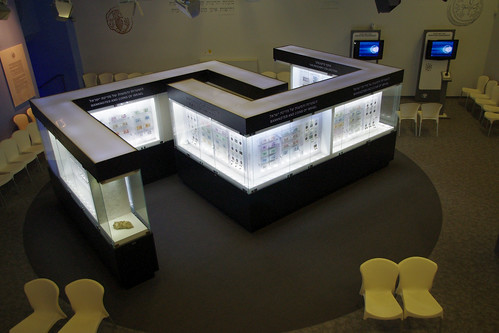 View of the lower level gallery
View of the lower level gallery
The layout resembles the currency symbol of the new Israel shekel
In Jerusalem, I visited the Bank of Israel, the nation's central bank. It's headquarters are immediately opposite that of the building of the Prime Minister. At the Bank, I visited my friend, Dr. Rachel Barkay, Curator of Numismatics, Currency Department. She showed me the Bank's new permanent exhibition. If you see the view of it from the second level, the design of the panels has a meaning to it. It represents the currency symbol for the new Israel shekel (NIS, ₪).
Also in Jerusalem, I met up with author and collector, Yigal Arkin. Yigal, who has a computer graphics and printing industry background, has written a number of books in both Hebrew and English about the coins and banknotes of Israel and the Palestine Mandate for the Bank of Israel. He has also worked on the current pamphlet describing the Bank's permanent exhibition. Yigal is finishing up an introductory book on U.S. paper money with many high-quality color images.
Just down the road from the Bank of Israel and the government complex of buildings is the Israel Museum. Here is a campus of a number of venues but after a renovation that was completed last year, the Museum complex houses the Archeology wing where you will find the museum's numismatic exhibition. Unlike prior to the renovation when the exhibition was displayed in one location, now coins are integrated throughout the galleries among the specimens of different eras, e.g., Greek, Roman, Byzantine, etc. Also on the Israel Museum campus is the Shrine of the Book where the Dead Sea scrolls are on display. There is also a 50:1 scale model of the ancient city of Jerusalem at the time of the Second Temple.
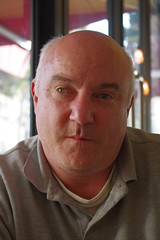
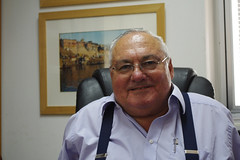 Yigal Arkin and Shlomo Tepper
Yigal Arkin and Shlomo Tepper
When we traveled to Tel Aviv, Israel's business city on the Mediterranean, to meet up with other family later, I had an opportunity to stop by and have lunch with Shlomo Tepper, a CPA by training who is a collector and author. He recently wrote, "The Unissued Banknotes of Palestine and Israel" which is in both Hebrew and English, of which he graciously autographed and sent me a copy when it was published.
I have no further trips until March when I visit Baden-Baden for a few days of R&R and then one week to my namesake city of Berlin to gather material for a travel book I've working on for several years.
THE BOOK BAZARRE
SKEWING INSTRUCTIONS, STEP-BY-STEP
I've noticed everybody is excited about this and asking about the technique, but nowhere was the exact process actually described. Here it is:
In Photoshop Elements 2.0, do this:
1) Select the portion of the image you wish to skew with the rectangular marquee tool.
2) Click Image, select Transform, click Skew.
3) Grab (ie. click and hold) the center point at top or bottom of your selection (not a corner point!) and drag.
Done!
In ArcSoft PhotoStudio 6, do this:
1) Select the portion of the image you wish to skew with the rectangular marquee tool.
2) Click the Transform button.
3) Click the Skew radio button.
3) Grab the center point at top or bottom of your selection (not a corner point!) and drag.
Done!
In both programs I would recommend that after Step 1 you actually create a new image (or layer) from the selection via Copy/Paste, rather than altering the original image. Then you can save (or copy) the results without affecting the original image file.
To read the earlier E-Sylum article, see: SKEWING - A TECHNIQUE FOR SIGNATURE IDENTIFICATION (www.coinbooks.org/esylum_v14n43a06.html)
MORE ON THOMAS ELDER PERIODICALS
Dan Hamelberg writes:
In response to Dave Hirt's request on Elder publications: The Numismatic Philistine does have a December, 1909 issue (Vol. I, #3) of 23 pages. Regarding the Elder Magazine, I have no issues beyond the Vol.2, #1, 1911 issue.
Tom DeLorey writes:
By great coincidence, I happened to have been sitting in David T. Alexander's library this past Saturday, and while there picked up a bound set of Thomas Elder's "The Numismatic Philistine" and "The Elder Monthly" magazines. After I got home Monday and read the last E-Sylum issue, I asked him to double check the issue dates, and his response was as follows:
Our bound volume shows The Numismatic Philistine Vol. I, No. 1 dated October 1909; No. 2, November 1909; No. 3, December 1909. The Elder Magazine Vol. I, No. 1 is dated January 1910; No. 2, February 1910; No. 3, March 1910; No. 4, April 1910; No. 5, May 1910; No. 6, June 1910; No. 7, July 1910; No. 8, August 1910; No. 9 [Convention Number] September 1910; No. 10, October 1910; No. 11-12, Nov.-Dec. 1910. Vol. II, No. 1, January 1911. End of the run.
"Philistine" was adapted from Elbert Hubbard's widely circulated magazine from East Aurora, N.Y., "The Philistine." Don't know if this was the end, W.W.C. Wilson bought The Numismatist right about this time and Elder folded his tent after pointing out that "an unfair discrimination" against him, by ANA officials (i.e. Farran Zerbe, who just sold the `official organ' to Wilson) had come to an end."
Mike Paradis forwarded this information about Tom Elder periodicals from two 1999 Kolbe sale catalogs:
George Kolbe sale 78, 09/25/1999. 197 Elder, Thomas L., Editor. THE NUMISMATIC PHILISTINE. VOL. I, NOS. 1-3. New York, October, November & December, 1909. Three issues com plete, all issued under this title. 20; 28; 23, (1) pages, text illustrations.
George Kolbe sale 77, 06/05/1999. 271 Elder, Thomas L., Editor. THE ELDER MAGAZINE. DEVOTED CHIEFLY TO COINS AND COIN COLLECTING VOLUME I, NOS. 1-12 & VOLUME II, No. l. New York, January, 1910-January, 1911. Thirteen issues in twelve, as issued, bound in one volume.
A complete run of this very rare publication, complete with the pictorial section of issue 9, depicting get-togethers at the 1910 American Numismatic Convention;
In his proem, Elder writes: "The ‘Numismatic Philistine' is no more. Doubtless the mourners will be few. While it may have performed a few real services for the cause of Numismatics, its political ‘murmurings,' had they continued might have eventually 'raised the roof' instead of accomplishing reforms.
One can tell that Elder made a real effort to reduce the tension between himself and ANA officials ("This magazine will refrain from taking sides this year in any political nomination), though at times he cannot restrain himself, complaining, for example, in one issue about the editorial content of The Numismatist ("It is high time to run a blue pencil through some of the impertinent, not to say unauthorized, criticism such as was indulged in the recent issue. Is the official organ getting to be a numismatic 'yellow journal?'") and, in another, he reports "Suppression of Important Numismatic News" (the Elder firm's advertisement for the Mougey sale was not printed in the July issue of The Numismatist and "Our $10. Has not been returned even").
The earlier numbers are largely filled with articles written by Edgar H. Adams and those interested in his numismatic specialties, U. S and pioneer gold coins, colonials, patterns, etc., will find it a source of useful information. Additionally, it contains a number of other interesting articles, along with seldom-encountered photographs of numismatic gatherings. All in all a fascinating publication, though relatively little-known due to its general unavailability.
 Brunk, Gregory C., World Countermarks on Medieval and Modern Coins. Retail: $35; now only $8.75 plus shipping to U.S. addresses.
Brunk, Gregory C., World Countermarks on Medieval and Modern Coins. Retail: $35; now only $8.75 plus shipping to U.S. addresses.To order, email Dave Hoch at davehoch@technologyarts.com or call (Cell: 617-833-3866).
Many other titles available! Price list available on request.
ALASKAN NATIONAL BANK NOTE THIEF SENTENCED

A locksmith was sentenced to serve three years in jail Thursday for the theft of historical bank notes worth about $400,000 from the estate of Fairbanks banker Bill Stroecker.
The three-year sentence was the maximum possible for former locksmith Forrest Holton.
Superior Court Michael McConahy said Holton's crime demanded high community condemnation because the victim was Stroecker's estate, which Stroecker left to local charities. Holton pleaded guilty to felony theft this summer. He has admitted to taking some of the currency in December 2010 when he was called to drill into four of Stroecker's safety deposit boxes at the downtown Key Bank. He has also admitted keeping a key to a new box and returning later to take uncut sheets of bank notes.
The theft went unnoticed for several months until a Fairbanks resident saw notes he recognized from Stroecker's collection on an online auction. Fairbanks police traced the online auction back to Holton.
Read more: Fairbanks Daily News-Miner - Fairbanks locksmith gets 3 years jail for theft from Bill Stroecker's estate
Except for a few bills worth about $700, all of the stolen currency has been recovered. The estate is suing the Holton and the Diebold company he worked for to recoup some $90,000 expenses related to the theft. Holton may also be ordered to pay some or all of these expense as criminal restitution.
To read the complete article, see:
Fairbanks locksmith gets 3 years jail for theft from Bill Stroecker's estate
(www.newsminer.com/view/full_story/16366808/
article-Fairbanks-locksmith-gets-3-years-jail-for-theft-from-Bill-Stroecker%E2%80%99s-estate)
To read the earlier E-Sylum article, see: MAN CHARGED IN THEFT OF RARE ALASKAN NATIONAL BANK NOTES (www.coinbooks.org/esylum_v14n30a16.html)
NOTES FROM E-SYLUM READERS: NOVEMBER 13, 2011
1841 Maundy Threepence Mintage
Regarding my summary in response to the question about how many 1841 Maundy threepences were struck, Martin Purdy writes:
This summarised answer isn't entirely correct, unfortunately: it's the number of "circulation strikes" that isn't recorded. The number of Maundy strikes is known, 2574.
To read the earlier E-Sylum article, see: MORE ON THE 1841 MAUNDY THREEPENCE (www.coinbooks.org/esylum_v14n46a20.html)
Greg Heim on Robert Yuell
Greg Heim writes:
Mike Packard and P. Scott Rubin were with my wife Lisa and I at Bob's remembrance service on November 1. Mike's summation of Bob's incredible life was superb. Even though he was known as "The Whister," I often referred to him as "The Venerable Master" when we were together. In a society where people talk way too often with their fingers and disconnect themselves from the world with headphones, Bob was the antithesis of that.
To read the earlier E-Sylum article, see: ROBERT YUELL, 1936-2011 (www.coinbooks.org/esylum_v14n46a05.html)
Dan Hamelberg on David Davis
Dan Hamelberg writes:
I was saddened to read in The E-Sylum that David Davis had passed away. He had made several visits to my library over the last few years to do research, and we spent many hours together sharing numismatic (and other collectibles) stories.
In addition to coins and numismatic literature, David had an extensive collection of pocket maps. I collect maps as well, (colonial) so it gave us another common ground for discussion. I looked forward to his visits and enjoyed the time spent in interesting conversation. He will be missed.
To read the earlier E-Sylum article, see: DAVID J. DAVIS, 1938-2011 (www.coinbooks.org/esylum_v14n46a06.html)
New E-Book By Ginger Rapsus
Ginger Rapsus has a new book in the works. She asks:
What if Beth March had lived?
Beth March was a character in "Little Women." "Concord" by Ginger Rapsus will be available as an e-book soon. The scheduled release date is December 1, 2011.
Ginger adds:
March and my heroine sell some old coins to finance a trip to DC. My next book, "Wild World," is the story of the young lady who inherits a 1873-S Seated dollar. Check out my Facebook page!
1986 Walter Breen Interview
Len Augsburger writes:
For all the stories I have heard about Walter Breen I never met him in person. This interview is about the next best thing. Thank you, David Lisot!
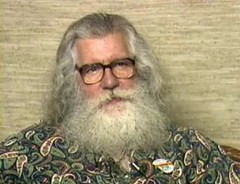
Walter describes his about-to-be-published Encyclopedia of U.S. Coins - he had the manuscript with him during the interview. One scary episode Walter recounts early on was riding in a car with Stuart Mosher when Mosher had a heart attack. Mosher turned pasty and motioned to the glove compartment, where Walter found a bottle of whiskey. Administering a capful to Mosher, his color returned. -Editor
To view the Breen interview video, see:
Walter Breen Interview from 1986
(www.coinweek.com/coin-guide/numismatic-history
/walter-breen-interview-from-1986/)
Speedy E-Sylum Readers Request Catalogs
Heath MacAlpine writes:
I want to thank Wayne for inserting my notice in last week's E-Sylum about my giveaway of extra Presidential Coin and Antique Company catalogs. I also want to congratulate Scott Rubin of New Jersey for being the quickest off the mark in asking for them. E-Sylum readers are a speedy bunch. The November 6 issue showed up in my e-mail box at 11:07 PM EST and I received Scott's request 23 minutes and 34 seconds later. I had a total of eleven readers request the catalogs, indicating a healthy interest in Joe Levine's well written sales catalogs of medals, tokens, and presidential memorabilia.
Gunter Kienast's Contact Information Sought
Henry Scott Goodman (
admin@karlgoetz.com
) writes:
I have misplaced Gunter Kienast's email address and I believe he still receives The E-sylum. I have a couple of questions for Gunter before deploying the new karlgoetz.com site on New Year's Day but currently have no way to reach him.
If you could pass this information request along to the E-Sylum readers I would appreciate it. Thank you.
QUICK QUIZ: RAY WILLIAMS' MYSTERY MARKS
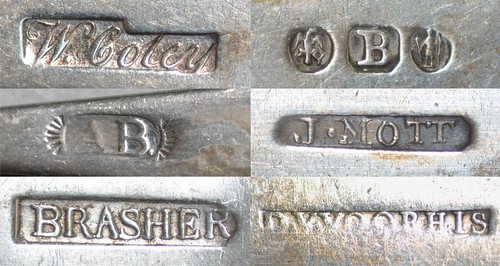
Ray Williams supplied the above image at my request. Who can tell us what these marks mean, and their numismatic significance? For extra credit, what do they all have in common? More next week.
COCKNEY ATMS AND BRITISH SLANG TERMS FOR MONEY
Philip Mernick writes:
Regarding the item about Cockney cash dispensers, an ATM I use locally has offered this "service" for maybe a year. I knew the screens were in Cockney but wasn't sure if it was used for receipts or statements. I tested it out Thursday when I passed it on my way to the weekly Spitalfields antiques market. All I got were statements and confirmation slips in plain English – boring!
Philip adds:
There is a whole range of English slang terms for money (see link). Although many of the names are probably invented some are used (pony, monkey, ton for example). Are there equivalents in the USA?
Philip provided this link. Below are some excerpts. www.philbrodieband.com/jokes_rhyming-slang.htm
To most people living outside London a "Cockney" is any Londoner; But a Cockney is a person born within hearing distance of the sound of Bow bells, the bells of the Church of St Mary Le Bow in Cheapside, London, EC2 . Although much of Cockney Rhyming slang has now become part of general speech, originally it was a secret language, thought to have originated in the 18th century by street traders to communicate with each other whilst trading illegally. (although it's roots may go far deeper) There is a lot of modern rhyming slang around these days.
Money Slang:
Paul McKenna = £10
Lady (Godiva) = Fiver = £5
Taxi Driver = Fiver = £5
Nicker or Quid = £1
Numbers:
1 = Lost & Won
2 = Bottle Of Glue
3 = Holy Sea
4 = Stand in Awe
5 = Jacks Alive
6 = Fiddle Stick
7 = Exeter in Devon
8 = Harry Tate
9 = Coal Mine
10 = Big Ben
To read the complete article, see: CASH MACHINE DISPENSES COCKNEY RHYMING SLANG (www.coinbooks.org/esylum_v14n46a22.html)
THE BOOK BAZARRE
MORE ON PEWTER TRIBUTE MEDALS
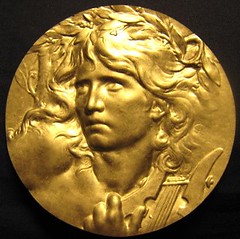
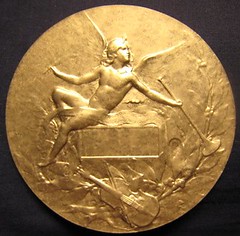
A couple weeks ago L. Michael Lawrence asked:
As a collector of French Art Nouveau medals, I have noted the recent appearance of "Pewter Tribute Medals" offered in the last few months by a single U.S. eBay seller. These pieces are inexpensive and appear to be modern reproductions of a variety of French medals, most notably of the Orpheus by Coudray.
Having purchased two of them, I observe that they are nicely done and quite accurate (Orpheus images attached). I have attempted to discover more about the origin and manufacture of these pieces by searching the internet and inquiring of the seller, but all websites lead right back to the eBay seller who is very polite but does not offer any details.
I'm curious to learn where and how these pieces are being made and seek input or information from E-Sylum readers.
W.J. Elvin writes:
I have had experience similar to L. Michael Lawrence - I bought two of these and then got interested in "the story." As he notes, the seller does not care to comment.
The seller also appears on the Etsy craft site and offers handmade items showing that he is quite the craftsman, and it may be a further clue to the source in that Etsy requires that new items offered be made by the seller. The Etsy site featuring handcrafts that incorporate materials such as the Orpheus medal is located at www.etsy.com/shop/blackjackdean .
Since I intend to write a bit about so-called tribute medals, I queried a number of dealers and others with some expertise regarding the product.
Dick Johnson delved into his wealth of numismatic definitions and said the work does not fit known definitions for tribute medal. I did however note that at least one commercial outfit, American Historical Society, which marketed gold coin replicas some years ago, used the term "tribute" to describe their offering. It would seem the proper term might be replica or copy when you consider that, according to Johnson, a tribute medal is issued in recognition of a living person, typically great or heroic.
Some of the experts who replied had not seen the items called "tributes", some thought they should be marked as replicas or copies even if the Hobby Protection Act does not include art medals, and Emmanuel Van Dorpe of the excellent ArtMedals.be site in Belgium, though he thought the Orpheus as seen in the newsletter "a good copy," said of other "tributes" he found on eBay: "They are poor copies, cheaply and badly made, and as you say, incorrectly named tribute medals."
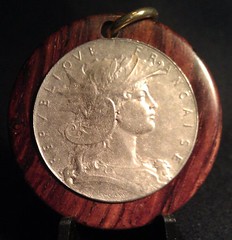 Pendant made from Cocobolo with a Pewter version of Marianne by Dubois.
Pendant made from Cocobolo with a Pewter version of Marianne by Dubois.
The Dubois engraving of Marianne is another very popular medal depicting the national symbol of France in helmet and armor. This pure lead free Pewter version is the way to go since it won't tarnish the way silver or bronze will and costs much less.
To read the earlier E-Sylum article, see: QUERY: PEWTER TRIBUTE MEDALS INFORMATION SOUGHT (www.coinbooks.org/esylum_v14n45a10.html)
WAYNE'S NUMISMATIC DIARY: NOVEMBER 8, 2011
Tuesday was Election day in Virginia, and political items were the theme for my monthly Northern Virginia numismatic social group, Nummis Nova. We met at J. Gilbert's steak house in McLean, VA. I had to work late and was the last to arrive. Already seated around a cozy table were Gene Brandenberg, Ron Abler, Joe Levine, David Schenkman, Julian Leidman, Eric Schena, Jon Radel, Chris Neuzil, Tom Kays, and our host, Roger Burdette.
The food and drinks were excellent, and I wouldn't be surprised if we end up going back. I think the wine was flowing well before I arrived, because this was one of the loudest and funniest dinners I can recall us having. What fun!
Tom Kays is never without a display, and among the items he brought was an example of the famous "end of pain" token. I found an example of the token (a "Conder" token attributed to Thomas Spence by Dalton & Hamer) online.
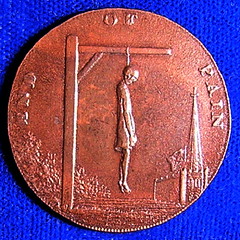

The inscription "END OF PAIN" is a pun on Thomas Paine, who was hated by most Englishmen of the 1790s. The designer is suggesting that the obverse scene would in fact be a welcome end to Thomas Paine. The inscription "THE WRONGS OF MAN" is an obvious jab at Paine's book "The Rights of Man" which was published in 1791. The date on the right leaf of the book 21 January 1793 is the date that King Louis XVI of France was executed. The suggestion here is that Paine's ideas lead to the death of the King of France and would do the same for the King of England if his ideas were to gain a following there.
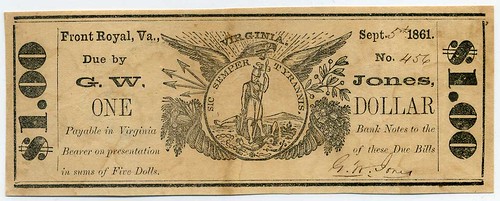
Eric Schena brought along a Virginia Readjuster Party ballot and a scrip note incorporating an identical vignette (above). He explained that the Readjuster Party campaigned on a platform of making West Virginia pay an apportioned share of Virginia's pre-Civil War debt. The issue wasn't settled until well into the 20th century.
The ballots (there were three in total) came from Bath Co. and were in a postal cover from the Bath County treasurer in Hot Springs to a merchant in Warm Springs. I like the fact that vignette was used almost 20 years later with almost minimal changes (if any at all). I have also seen that vignette used as newspaper mastheads from the same timeframe. A fascinating bit of local lore, especially considering the question of WV's pre-Civil War debt wasn't settled until 1915 and the last payments weren't made until the 1930s.
Chris Neuzil showed off this set of dimes with an interesting connection. His friends Joanne and Bruce Taylor have two Rottweilers, so they get out a lot walking the dogs. Each dime was spotted by eye on a walk near their home in Reston, VA.
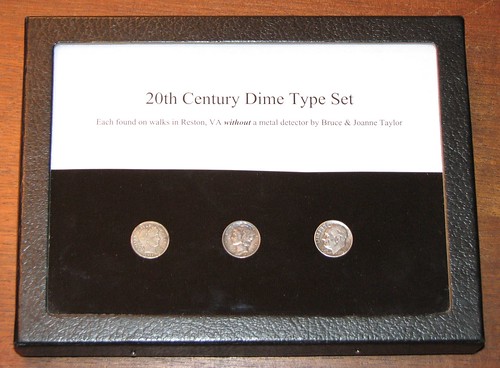
Chris writes:
I thought it was amazing that they found all three 20th century design types and that they are in such nice shape. The Merc even has quite nice toning. Neither of the Taylors is a collector. And yes - they have kept looking at and around the find locations. The dates are 1913, 1936, and 1956.
I brought along a book I'd recently won in a Kolbe & Fanning auction lot 1320, Sale 122). Dave said something like "Well what do you know about that? - Wayne brought a book - surprise, surprise!". It's an inscribed dedication copy of Fancies in Thoughts and Verse", a compendium of poems by an important U.S. numismatic author, Augustus Heaton.
I passed the book around and asked, "OK, let's see which one of you dolts is the first to tell us what numismatic book Heaton wrote." I think it was Joe Levine who joked, "it was those Heaton counterfeit detectors, right?"
Chris Neuzil won the dolt-of-evening award, correcting identifying Heaton's "Mint Marks", the first book devoted to coinage of the U.S. branch mints.
The book does include some numismatic verse, including "A Miss Taken Scent" and "The Numismatist and the Burglar". The book arrived the week that the American Numismatic Association's Executive Director was relieved of his duties. When I took the book out it opened naturally to "The Amorous Numismatist".
When people started retelling the same jokes I'd heard earlier in the evening I knew it was time to leave. But the food and drink were nearly as memorable as the evening. What a great night of numismatic fellowship.
KOLBE & FANNING NUMISMATIC BOOKSELLERS WEBSITE
BRITISH STONEMASONS UNCOVER HIDDEN COINS HIGH ATOP CHURCH
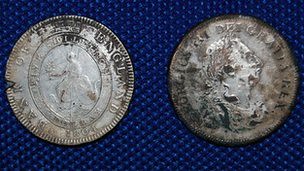
Two Georgian silver coins have been found hidden at the top of a church tower in Worcestershire.
Stonemasons working on the tower of St Andrew's Church, Ombersley, found the two large coins buried deep in the masonry.
The coins bear the inscription "Bank of England 1804 Five Shilling Dollar".
Stonemason Brad Steel, who found the coins, said: "When the coins were put into the building it would have been quite a chunk of the mason's wages."
He added: "We do leave coins in masonry for other masons to find - the surprising thing about these coins is the value of them."
The coins had been carefully placed in a circular socket in a buttress 80ft (24m) up the church tower.
Churchwarden Robert Thornton said the coins have an interesting history: "They were originally Spanish coins that were looted by this country and held in the Bank of England, and in 1804 they were re-issued in response to a shortage of high-value coins."
They will now be put on display in the church.
Mr Steel intends to continue the stonemason's tradition of putting coins in their finished work, once the restoration of the church is complete.
"I'm going to replace them with new coins with the 2011 date on them but I won't signify where those are.
"We keep it a secret and, hopefully in another couple of hundred years, another mason will find those."
An E-Sylum writes:
The masons have added 2011 dated coins to take their place, and perhaps these will be found by a future generation.
To read the complete article, see: Ombersley's St Andrew's Church's silver coin secret (www.bbc.co.uk/news/uk-england-hereford-worcester-15673627)
LANGUAGE ON COINS AND CURRENCY OF LANKA
Kavan Ratnatunga writes:
I wrote a short article titled "Language on Coins and Currency of Lanka" based on a presentation I made in Sri Lanka.
 Most of the indigenous coins of ancient Lanka had only symbols. The rare lion and swastika lead coin has Brahmi text along the periphery around the railed swastika. This symbol which is seen cut at the commencement of stone inscriptions by Lankan kings, is recognized as the Royal standard of the early Anuradhapura era.
Most of the indigenous coins of ancient Lanka had only symbols. The rare lion and swastika lead coin has Brahmi text along the periphery around the railed swastika. This symbol which is seen cut at the commencement of stone inscriptions by Lankan kings, is recognized as the Royal standard of the early Anuradhapura era.
Sri lak viha appears on the 8th century gold kahavanu coin. The coins of RajaRaja Chola replaced lak viha with RajaRaja. After Lanka was liberated in 1070 we find coins in the names of VijayaBahu, ParakramaBahu, Nisankamalla, Sahasamalla, Lilavati, Dharmasokadeva, Buvanekabahu. Most of the coins of latter monarchs are minted in copper. Known then as Massa of which large numbers are found in hoards. All these medieval coins had text in DevaNagari.
The 15uh century Setu massa are the first Lankan coins with Thamil text. They were issued by the Arya Chakravartis in Jaffna between 1462 and 1597. These copper coins has the Standing Monarch characteristic of most medieval Lankan coins. In this coin the word Setu appears below the Nandi bull couchant facing left.
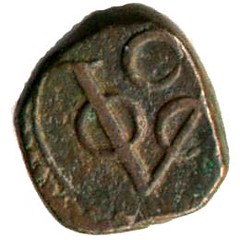
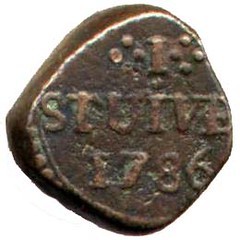
Dutch coins had the VOC (Verenigde Oostindische Compagnie) monogram of the Dutch East India Company. These crude thick Copper Dump coins were minted locally between 1783 and 1795 in Colombo, Trincomalee, Galle and Jaffna. Colombo (C) had STUIVER and Trincomalee (T) had ST. The Galle (G) had value in Sinhala text and the Jaffna (I) had Thamil text.
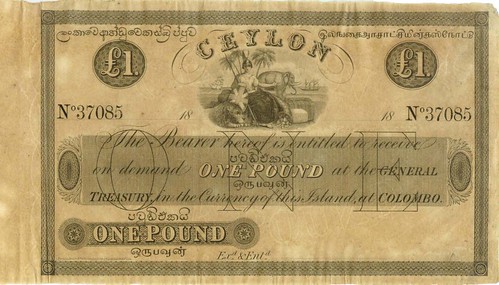
Lanka's first currency note was issued in 1785, which was in Rix Dallars and called Kredit Brieven and payed 3% Interest. It had text in Dutch, Sinhala and Thamil. This Dutch liability was taken over by British in 1796.
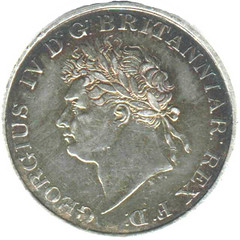
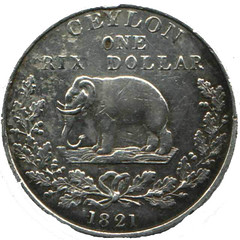
Early British coins had a standing Elephant facing left with CEYLON GOVERNMENT. The locally minted copper dump coins from 1801 to 1816 had value as a fraction of a Rix Dollar (48 Stivers), and the Silver Dump coins minted from 1803 to 1809 had value in Stivers. The very iconic Silver Rix Dollar coin of 1821 has George IV. All these coins had text only in English.
To read the complete article, see: Language on Coins and Currency of Lanka (coins.lakdiva.org/notes/language.html)
DAILY MAIL ARTICLE ON MONEYFACING
 It's time to put your money where your mouth is if you want to be part of a rising internet craze.
It's time to put your money where your mouth is if you want to be part of a rising internet craze.
Moneyfacing is the practice of folding a bank note in front of your face and taking a photograph to create a hybrid face.
Facebook groups dedicated to the craze have been set up and internet forums have popped up containing hundreds of photos.
The include images of currencies from across the world and while some appear to naturally follow the subject's face, others are simply hilarous.
One user who posted a picture of himself with the Queen's face on the 5 pounds wrote: 'I'm not sure how proud Liz would be if she saw this but I think I wear the crown rather well.
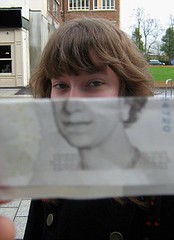
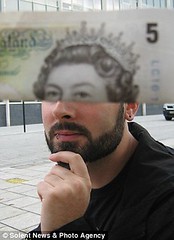
To read the complete article, see:
Money talks! The fun hybrid faces that match people with banknotes
(www.dailymail.co.uk/news/article-2060407/
Money-talks-The-fun-hybrid-faces-match-people-banknotes.html)
FEATURED WEB PAGE: ALUMINUM COIN COLLECTOR'S SOCIETY
This week's Featured Web Page is the Aluminum Coin Collector's Society.The Aluminum Coin Collector's Society was founded on January 2nd, 2011 to promote the knowledge, appreciation and collecting of aluminum coins, medals and tokens from around the world.
The Society is free for anyone who wishes to join, simply send an email to aluminumcoins at yahoo.com and you will receive your official member number, and perhaps an occasional newsletter and hopefully, in time, a membership card that you can print out from home.
The goal is to eventually become an ANA Member Club with meetings held at various large numismatic shows and events.
Billy Kingsley
Founder, President, and Member #1
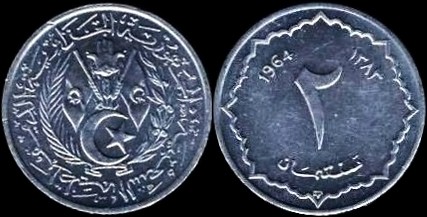
public.fotki.com/AluminumCoinCollectorsSociety/

